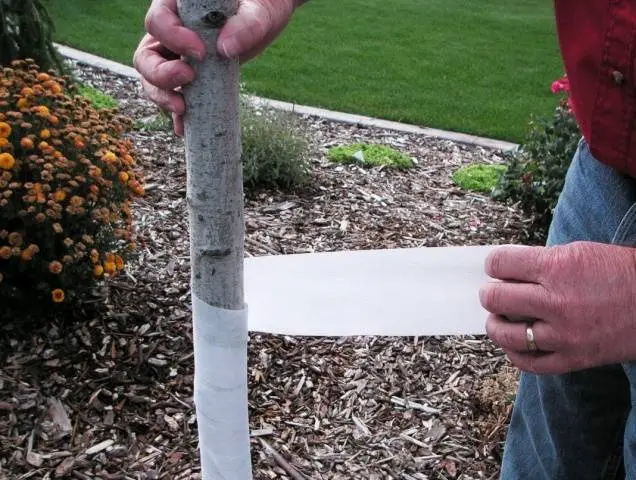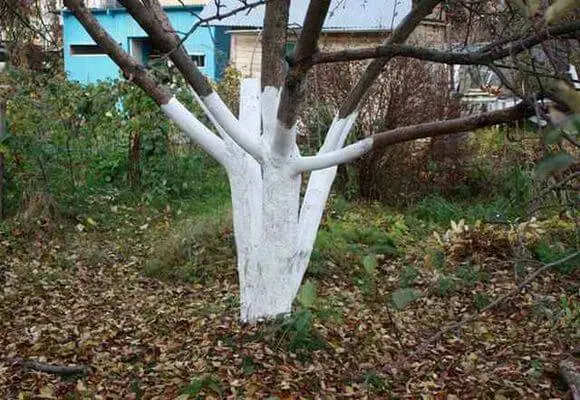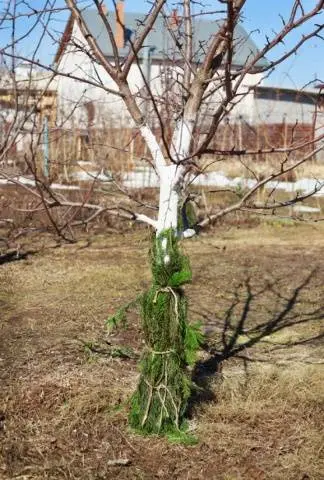Contents
The struggle of gardeners with various pests does not end with the onset of cold weather – the turn of field mice comes. If winged destroyers of fruits and leaves fall asleep in winter, then rodents, on the contrary, become more active, because in their natural habitat (in forests and fields) it becomes cold and hungry. Vole mice approach human dwellings in search of food; one of the most delicious “treats” for these animals is the bark of young apple trees. Although damage to the trunks of mouse teeth is not as critical as the damage caused by larger rodents, it is better to prevent these troubles than to deal with their consequences.

What to do if the bark of apple trees has been gnawed by mice will be discussed in this article. Here you can also find information on how to protect young trees, what methods of rodent control are best used.
Harm caused by rodents
Mice, hares and wild rabbits can completely destroy the orchard. The fact is that stone and seed trees are a favorite delicacy of rodents. By the way, mice damage trees much less than hares and other rodents.
The small teeth of field mice are able to gnaw through only the top layer of the apple tree – the bark. Often the cambium remains intact, which allows the tree to quickly regenerate and continue fruiting.
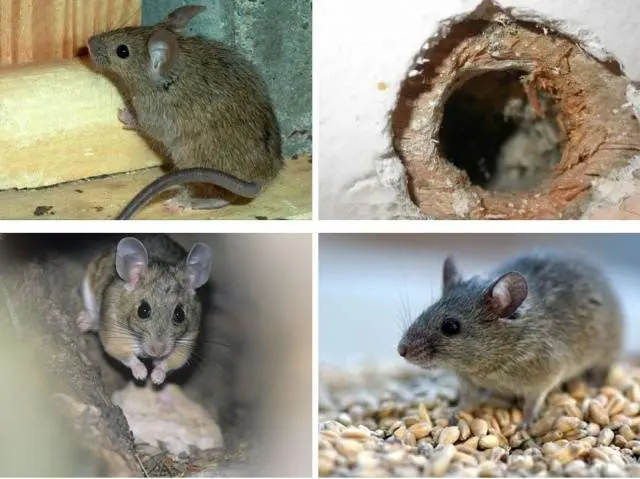
Mice are most active in gardens in late winter – early spring. It is by this time that the stocks of rodents usually run out, and there is absolutely no food left for them in the fields and in the forests.
If there is snow on the site, the mice will damage the part of the trunk that is under the snow. Therefore, the gardener may not immediately notice that mice have eaten the bark of apple trees, usually traces of the presence of rodents are found in the spring, when the snow melts. The most important thing in this case is not to waste time and immediately proceed to the resuscitation of the apple tree.
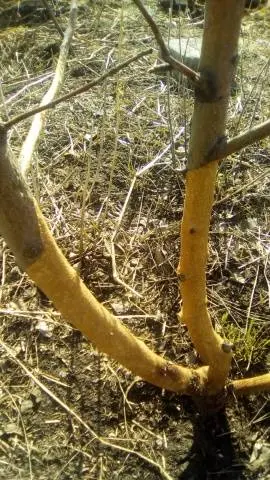
Mice gnaw not only the bark and trunks of young apple trees, these animals are able to destroy even the roots of an old tree. If in the spring the apple tree collapsed on its side, and its trunk easily turns in the ground, then most of the roots are damaged – the tree will certainly die, as it does not receive nutrition. Such plants will have to be uprooted – it is impossible to save apple trees with root damage by more than 80%.
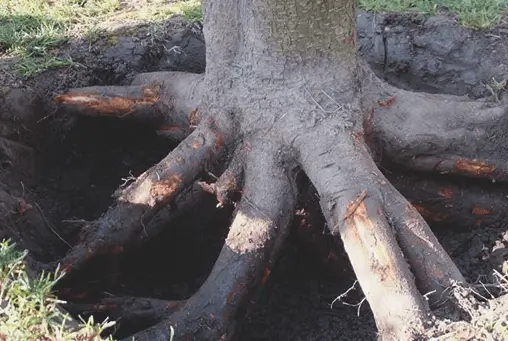
How can a tree be saved?
If mice have gnawed on the bark of apple trees, the most important thing is not to waste time and start saving the tree immediately. As soon as the snow melts, the gardener should walk around the site and inspect all fruit plants. Depending on how hard the mice gnawed at the bark of apple trees, a method is chosen to save and treat the tree.
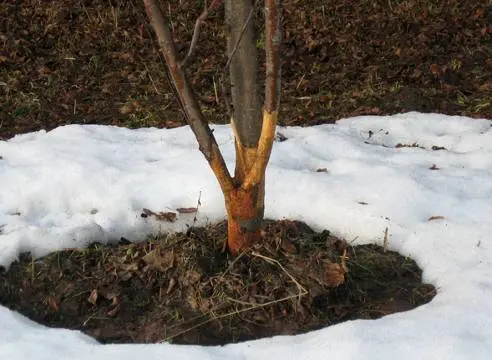
Medical dressings
Apple trees gnawed by mice not very much can be treated with bandages. This will only help if the problem was detected on time, the bark has not yet begun to dry out. The most important thing is that the cambium and the core are not damaged.
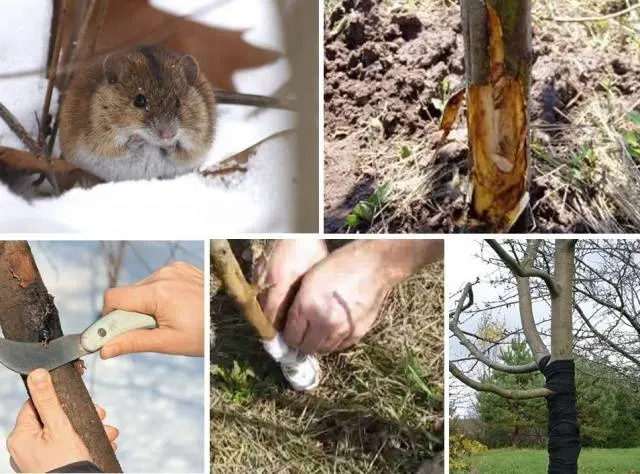
There are many ways to treat bandages. Here are the most common and effective ones:
- The place where the mice gnawed the bark of an apple tree is smeared with a thick layer of ointment. “Heteroauxin”, garden pitch is applied on top and the trunk is tied with gauze or a clean natural cloth. From above, the bandage must be closed with polyethylene so that infection and moisture do not get into the wound.
- Can be welded linden decoction. To do this, take a pack of dried linden (200 grams) and pour it with a liter of water. This mixture is boiled under the lid for 30 minutes. The broth must be cooled and filtered through cheesecloth. Pure linden broth is thoroughly soaked with wounds inflicted by the teeth of mice. After that, the trunk of the apple tree is bandaged with cloth and film, leaving the bandage for the whole summer.

- Clay talk – one of the most ancient ways of treating apple trees after mouse attacks. Six parts of clay must be dissolved in water and mixed with four parts of cow dung. The mass should be thick. Its thick layer (about three centimeters) is applied to the damaged trunk of an apple tree, then the tree is wrapped with natural cloth. Another layer of clay is applied on top of the fabric and the tree is not left in this form for the entire warm season. You can not remove such a bandage for the winter: clay with fabric is easily torn and decomposed, leaving no constrictions on the growing apple tree. Already next spring, a new bark should grow on the trunk.

- If the gardener does not have the ingredients or time to prepare the mash, you can use the finished composition. “RanNet”. This special bactericidal putty promotes the rapid healing of any wounds on fruit trees. It is applied with a brush on a clean trunk. After drying, the product leaves a durable film that will not crack and let moisture through.
- The wound on the bark caused by mice will quickly heal after treatment blue vitriol. For this, a three percent solution is suitable. They impregnate the trunk of an apple tree, when the product dries, wrap the tree with black polyethylene. Polyethylene will protect the wounds from water and light, by the end of the season the bandage can be removed.
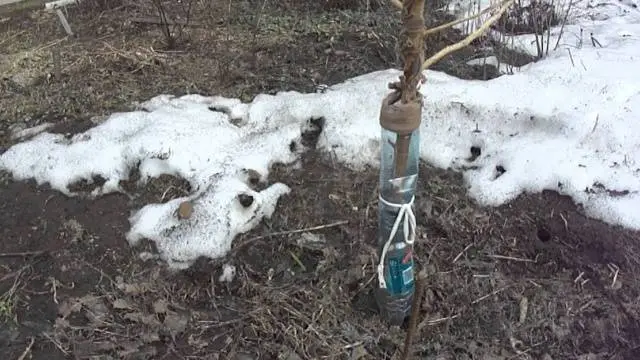
wound grafting
In more complex cases, when the nutrition of the tree is disturbed, grafting with a bridge is used. If the mice ate not only the bark, but also the cambium, it will be more difficult to save the apple tree, but it’s worth a try.
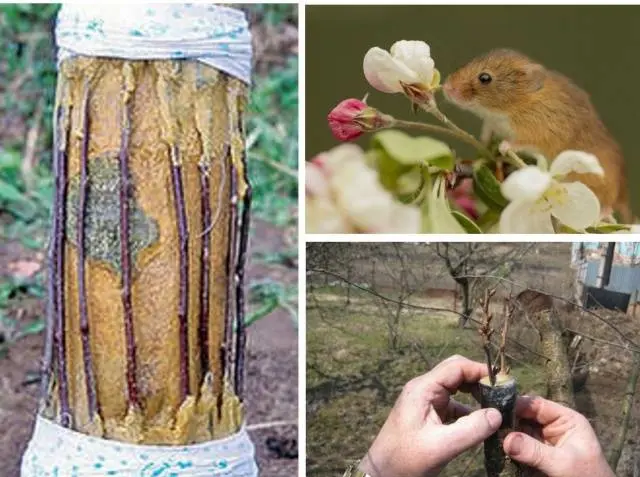
You need to graft an apple tree with a bridge like this:
- as soon as the snow melts, the wound caused by mice is cleaned to clean wood;
- after that, the trunk is treated with a one percent solution of copper sulfate;
- several last year’s young shoots are cut from the tree and cut into equal segments, the length of which should be 5 cm longer than the vertical dimensions of the wound;
- cuttings are cut at an acute angle from both ends;
- in the areas of the bark of the apple tree above and below the wound, cuts are made in the form of the letter “T”;
- prepared cuttings are inserted into these incisions.

The junction (grafting) is lubricated with garden pitch and rewound with polyethylene.
The essence of this method of resuscitation of an apple tree after the action of mice is that the shoots will take root to the bark and begin to nourish the tree, acting as a damaged cambium. Over the years, bridge shoots will become thicker and eventually turn into a full-fledged trunk for an apple tree.
Engraftment of the bark
This method of tightening the wounds left by mice is quite complicated – only experienced gardeners can implement it. The method of engrafting the bark to a bare area is especially effective, when the mice gnaw the trunk in a circle, leaving not a single centimeter of coverage on the tree ring.
To make the method a reality, you need to find a donor apple tree or cut the bark from a thick branch of the same tree. The transplant bark is cut very carefully using a sharp knife. The dimensions of the patch should be 5 cm larger on each side than the wound left by the mice.
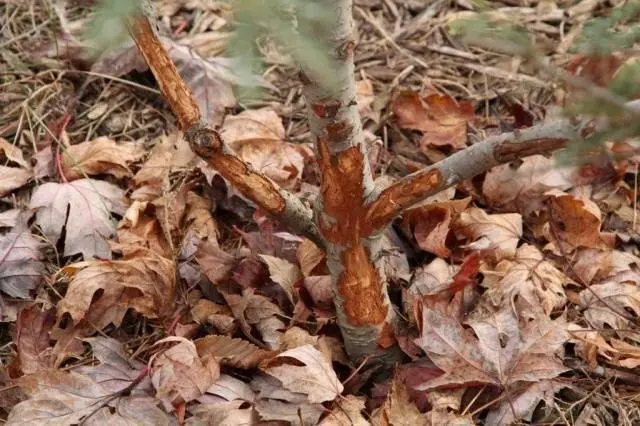
The bark is applied to the gnawed trunk and wrapped with electrical tape. In order for the apple tree to recover, it needs to be watered and fed – to provide full care. With the onset of winter, the tape is removed.
Trunk cut for reverse growth
If the mice damaged the trunk of an apple tree very badly, at least part of the tree can be saved only in a cardinal way – cut down the trunk above the lower bud. Use the method even before the start of sap flow: this is very important!
So that the stump does not germinate, it is abundantly smeared with garden pitch. If the roots of the apple tree were healthy and strong, in the spring they will grow thick growth. From this growth, the gardener can choose a trunk for a new tree.
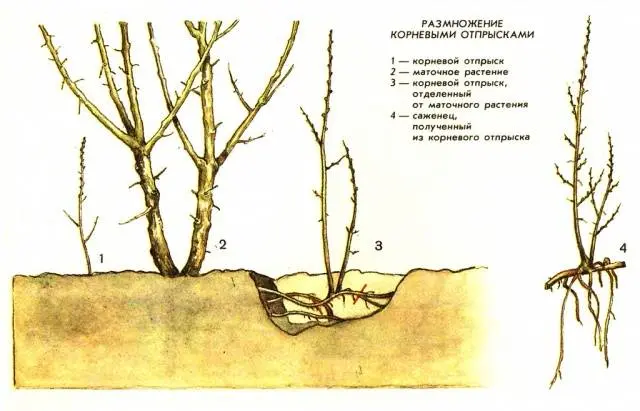
Protection of trees from rodents
It is difficult to reanimate apple trees after their trunks have been eaten by mice, and besides, the gardener must understand that after “treatment” the tree will never be as prolific as before.
therefore the owner of the orchard should direct all his efforts to preventive measures – protecting apple trees from mice and other rodents.
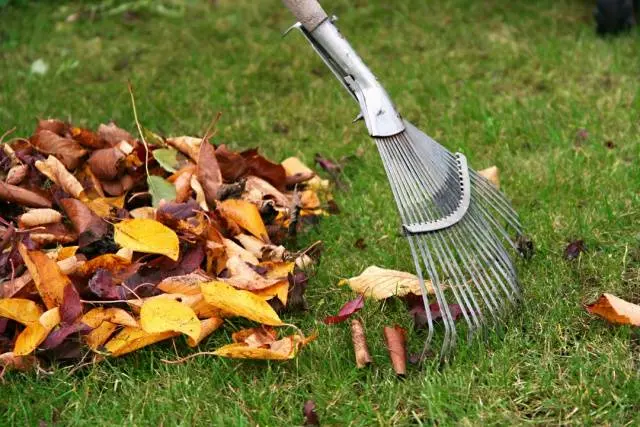
Protecting apple trees from mice primarily consists in autumn garden cleaning:
- all branches, grass and other plant debris must be collected and taken out of the site;
- fallen leaves should be burned or dumped into a compost pit.
Protective measures may include the following:
- Whitewashing apple tree trunks. The trunk and skeletal branches are coated with garden paint to a height of about 150 cm (it is up to this height that hares reach, standing on their hind legs).

- Mice can’t stand the smell copper sulphate. You can spray the crowns of apple trees and the soil around them with a solution prepared at the rate of 100 grams of vitriol per 10 liters of water. For a young apple tree, two liters of a protective agent is enough, an adult tree needs at least a bucket of solution for full processing. Processing is carried out in dry weather, when the leaves have completely fallen off and will be removed from the garden.
- As soon as frosts begin, you can process apple trees Bordeaux mixture Mice don’t tolerate it either. A one percent solution will scare away not only mice, it will destroy insects wintering in the bark and roots of apple trees. The amount of funds should be the same as in the previous paragraph.

- A mixture of naphthalene and fish oil – not the best delicacy for mice. In a ratio of 1: 8, these two components are connected and the lower branches and trunk are coated. Around the apple tree, you can lay out a cloth soaked in naphthalene mixture. After each rain or snowfall, the treatment is repeated!
- Sanlysol mice and rabbits don’t like it either. You can soak sawdust with this product and scatter them around the trunk of an apple tree. Or you can mix sanlisol with clay and coat the bottom of the tree.
- Apple tree seedlings protect spruce branches. The branches are tied to the trunk, pointing the needles down, trying to cover the root neck.

- The smell of elderberry disgusting for mice. Twigs with this berry can be laid out in the garden.
- To prevent mice from making moves in the snow, snow is regularly trampled down. This will allow an ice crust to form and compact the snow mass.
- A more radical way fencing apple trees with netting. The grid is buried half a meter into the ground, the height of the above-ground fence should be at least one and a half meters.
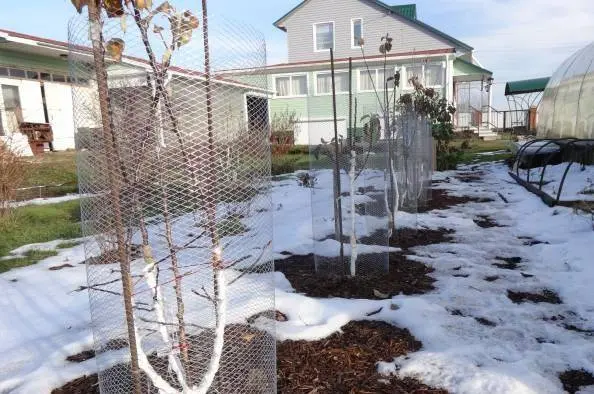
Conclusion
Mice often gnaw the trunk of an apple tree, exposing the core of the tree, disrupting metabolic processes and nutrition. Infections and moisture can penetrate through wounds, as a result of which fungal diseases develop – the tree becomes weak, often sick, bears fruit poorly, and stops developing.
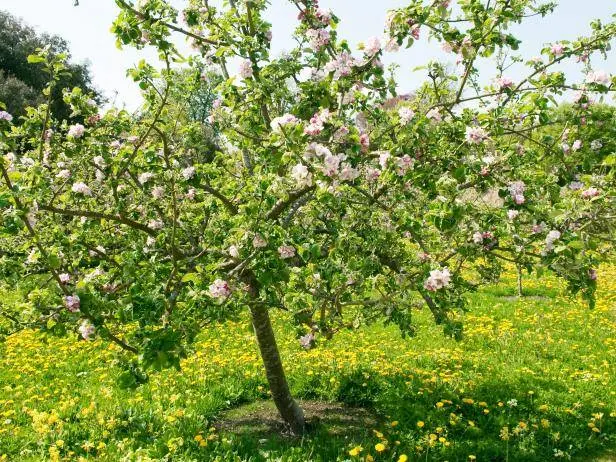
To protect the apple tree from mice, you need to use fences, non-woven fabric, ultrasound, baits and products that smell unpleasant to rodents. Already damaged trees can be tried to be cured, choosing a method depending on the depth and area of uXNUMXbuXNUMXbthe wound.










